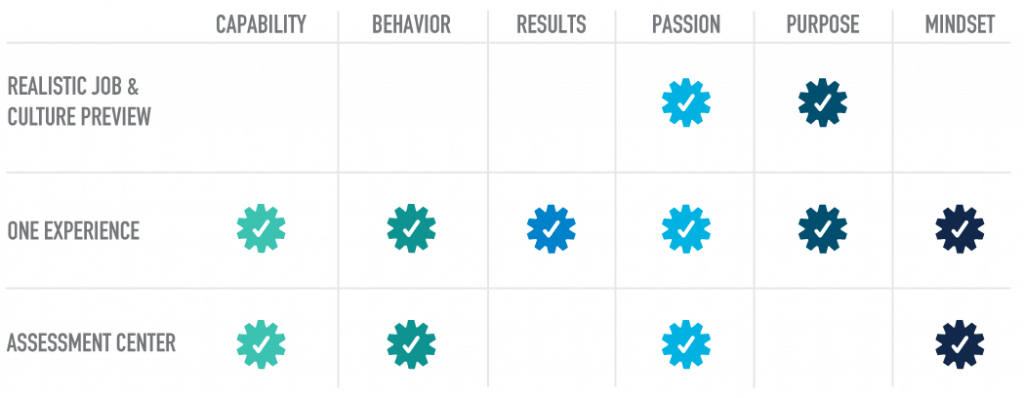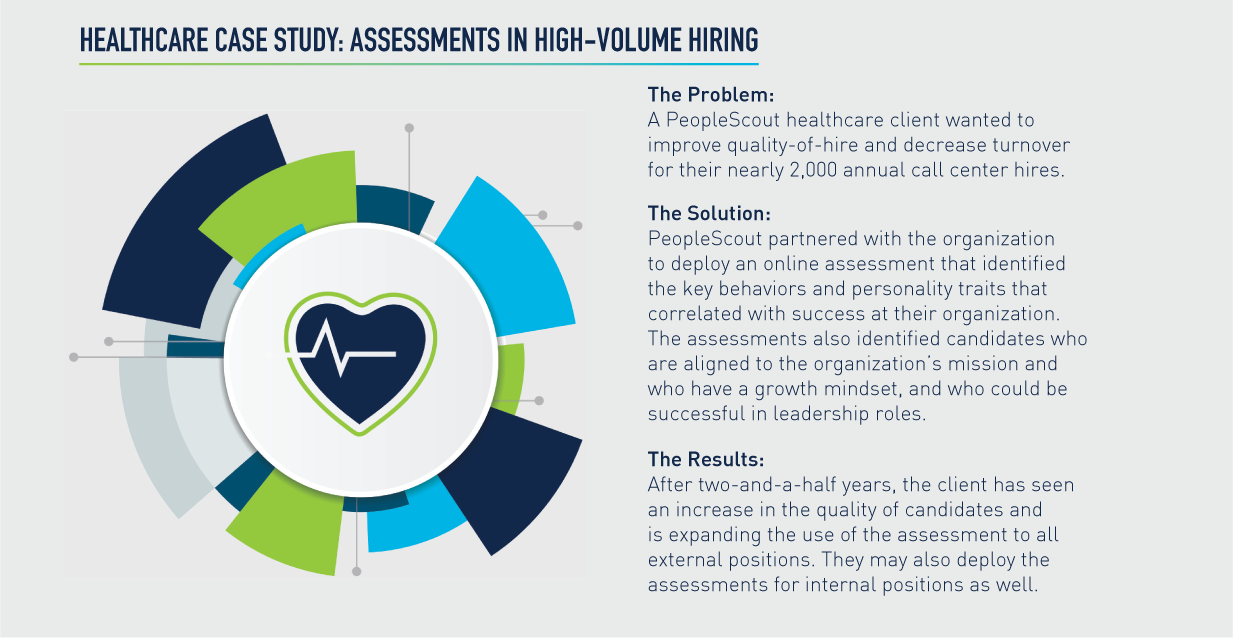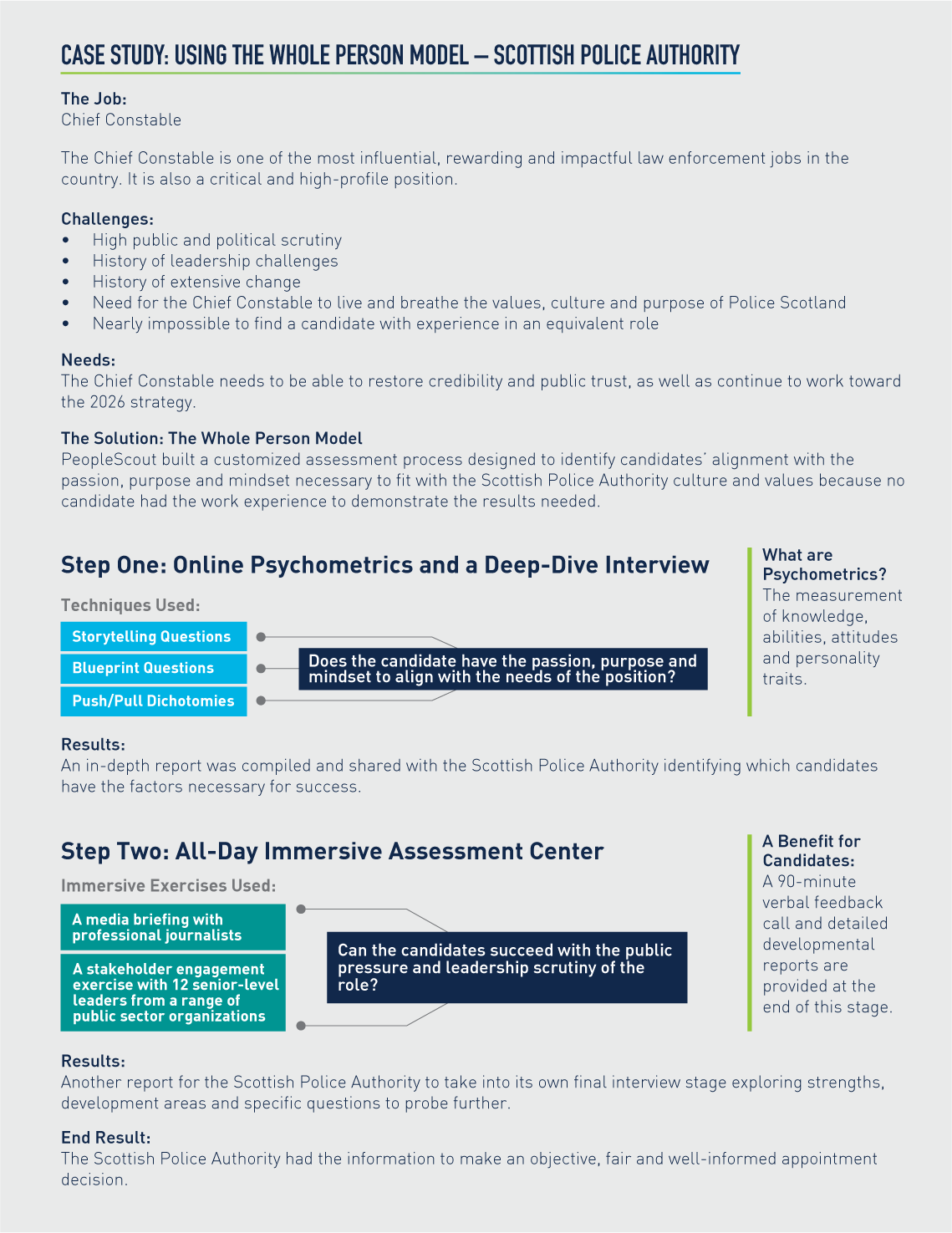The whole person model is a highly bespoke assessment process. We have found that the model functions best in two contexts: high-volume hiring and highly specialized leadership hiring.
If an organization needs to hire a large number of candidates for a specific role or type of role, the whole person model can produce stronger, more diverse candidates and can result in longer-tenured employees. The process of building out the tailored assessments is time- and cost-effective for high-volume hiring.
The whole person model can also be valuable when searching for the right candidate for a leadership role. For organizations in times of transition, it can be especially difficult to identify candidates with the ability to lead through change.
In this article, we will explain how we at PeopleScout apply the model practically to both hiring examples.
Whole Person Model Use Case: High-Volume Hiring

This infographic is one example of the whole person model in practice for high-volume hiring. It includes three stages and each stage measures different aspects of a candidate’s background, or gears of the whole person model:
- A realistic job and culture preview
- The One Experience online assessment
- The final stage of online assessments, which we call the Assessment Center
During the realistic job and culture preview, a candidate gets a practical look at what it would be like to work for your organization and in this particular role. This section will include media like a video job description, shaped by your EVP and employer brand and customized to a job’s responsibilities.
Showcasing the job and the employer brand of the organization is critical during the realistic job and culture preview because it assesses the passion and purpose of the candidate. If the candidate identifies with and is enthusiastic about your organization, they will continue through the process. If a candidate does not feel as though their passion and purpose align, they will not continue in the process.
The One Experience assessment is an online holistic tool that assesses each part of the whole person model. Candidates answer questions in a variety of formats that allow them to demonstrate their different strengths Each of the six factors is weighted differently based upon their ability to predict candidate success and the requirements and expectations in a role.
In the One Experience tool, the scores for each type of assessment will be combined and weighted, and candidates who meet a certain threshold will be moved along to the next step. Because there are a variety of ways to earn a passing score on these assessments, there will be a more cognitively diverse group of candidates that make it through this part of the process.
At this stage, the assessments include automated feedback reports so that candidates have a better understanding of why they do or do not move forward. This improves the candidate experience because candidates who do not get the position are not left in the dark. It gives them an opportunity to see why they may not have been the best fit.
The final step is the last set of online assessments, which we call the assessment center, to further narrow the candidate pool. In this example, it measures mindset, passion, capability and behavior. However, it can be adapted to focus on the categories that show the strongest predictive ability for a specific position. This stage also includes automated feedback reports.
Using this model, we see fewer candidates making it past the realistic job and culture preview to complete the One Experience tool, but 50 percent of those who do complete that step go on to pass and move to the assessment center. Those who make it to the assessment center have a pass rate of 75 percent, which is higher than the traditional process. In the old process, clients viewed a pass rate of 50 percent at this stage as high.

Whole Person Model Use Case: Leadership Hiring
In the case of leadership hiring, rather than using the One Experience tool, the whole person model uses a deep-dive interview in which the questions are designed to assess the candidate’s passion, purpose and mindset, as well as their capability, behavior and results – the six factors included in the model. By assessing top candidates for these factors, organizations can better identify leaders who fit well with their organization and goals.
To understand how this works, let’s look at how we applied the whole person model to help the Scottish Police Authority appoint the next Chief Constable for Police Scotland.

How did this impact the onboarding process?
The new Chief Constable continued the developmental work they invested in during the assessments process and received a series of coaching sessions throughout the transition.
All candidates reported a positive experience that provided ample opportunity to demonstrate their capability and suitability for the role.
Applying the Whole Person Model to Your Hiring
In the current economic climate, employers who hire and retain candidates with a growth mindset and who align with the passion and purpose of the organization will be at an advantage. By assessing for these factors and looking at the whole person, employers can better identify those candidates and set themselves up for success.
When employers face the challenge of hiring a large volume of employees, the model can be customized to efficiently identify the best candidates with a passion for the work and the organization. When an organization is looking to make a leadership hire but is struggling to find candidates with relevant experience, the model can be customized to identify those who can learn, lead and grow with the organization.
Key Takeaways:
- The whole person model is a bespoke process and works best for high-volume and leadership hiring.
- When used for high-volume hiring, the whole person model can produce stronger, more diverse candidates and can result in longer-tenured employees.
- When used for leadership hiring, the model can identify leaders who fit well with an organization and its culture and goals.
This article is the third in a series, you can read the first article, Assessing for Passion, Purpose and a Growth Mindset: Drivers for Change, hereand the second, Assessing for Passion, Purpose and a Growth Mindset: The Current State of Assessments and a Better Way Forward, here.



